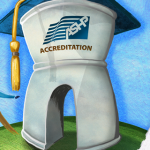ASHP’s New PhORCAS™ System Streamlines Residency Application Process
Website Allows Applicants to Submit, Track Applications Online
 With the October launch of its Pharmacy Online Residency Centralized Application Service™ (PhORCAS™), ASHP has pushed aside the typically cumbersome, paper-laden residency application process to make room for a more efficient and convenient alternative.
With the October launch of its Pharmacy Online Residency Centralized Application Service™ (PhORCAS™), ASHP has pushed aside the typically cumbersome, paper-laden residency application process to make room for a more efficient and convenient alternative.
“The residency application process has been slow and labor-intensive,” said Kate Farthing, Pharm.D., BCPS, pharmacy clinical specialist, quality and patient safety, at Legacy Good Samaritan Medical Center in Portland, Ore. Dr. Farthing, who is a former residency program director, also served on the PhORCAS design team. “Our goal was to streamline the entire process for both applicants and residency programs.”
With PhORCAS, applicants can submit and track their applications—and all supporting material—through a single website. Similarly, residency program administrators can receive and organize those applications through their electronic portal.
All residency programs that are registered with the National Matching Service (NMS) and have a unique NMS number are eligible to participate in PhORCAS. To date, all of the approximately 1,500 residency programs in the ASHP accreditation process recruiting for positions in the 2013 match are committed to using PhORCAS.
More Pharmacy Students Seeking Residencies
PhORCAS emerged in response to the dramatic increase in the number of residency applications over the last few years, as pharmacy students seek a competitive edge in an uncertain job market. In 2011, more than 4,000 applicants applied for 3,000 residency positions through the ASHP Resident Matching Program, according to Janet Teeters, M.S., director of ASHP Accreditation Services.
“It’s a capacity issue,” she said. “Some residency programs receive more than 200 applications. How do you possibly process that amount manually?” In fact, the influx has created administrative overload as programs struggle to keep pace.
“Imagine that you are heading up a residency program, and your staff has to collate and coordinate all of the pieces of an application into one file for each candidate,” said Dr. Farthing. “You may receive 50 to 100 or more applications over a short period of time, each application has eight to 10 supporting documents, and they all arrive by mail at different times. This creates a major burden for programs seeking the best candidates.”
Applicants have felt the crunch, too, as some residency programs began imposing tighter submission deadlines to compensate for the surge in application volume. According to Teeters, deadlines used to fall in February. But as programs tried to maintain control over the paperwork, many began bumping their deadlines up to earlyJanuary.
“Considering that most applicants don’t decide which programs they’ll apply to until after ASHP’s Midyear Clinical Meeting in early December, that’s a lot of pressure to get everything together and mailed out in time,” said Teeters.
Providing a Little Peace of Mind
PhORCAS is intended to put an end to all of that. Applicants gather and submit every component of every application electronically, including transcripts, recommendation letters, and program-specific supplemental information. They can easily track the status of their applications online at any time, precluding the need to bombard residency programs with anxious phone calls and emails wondering what has been received.
Residency programs spend an inordinate time responding to such inquiries from applicants, noted Dr. Farthing, adding that “there won’t be a need for that anymore because both sides can see the same information in real time.”
PhORCAS also allows residency programs to organize large numbers of candidates and sort them by predetermined criteria, which helps them to isolate candidates who are good matches for their particular programs.
And although most of the application material is standardized under PhORCAS, the system still allows residency programs to customize their submission requirements to accommodate variations such as application dates, supplemental materials, and the specifics required in an applicant’s statement of intent. Reference letter writers must use a standardized reference form, but they can opt to write and upload personalized recommendation letters as well.
“Residency programs can continue to follow their own processes the same way that they always have,” said Teeters. “We’re not replacing any part of that or asking them give up any of the individuality.”
“From my standpoint as a residency director, the process will be much more manageable,” said Jenny VanAmburgh, Pharm.D., associate clinical professor and assistant dean for academic affairs at Northeastern University, Boston. “All the information I need will be easily accessible.”
Cost, Time Savings Built In
The cost for applicants to use PhORCAS is $75 for the first four applications and $25 for each additional application. That’s comparable to the pre-PhORCAS application process, according to Teeters. She added that applicants stand a lot to gain from the new system, including:
- The ability to compile a single online submission, which PhORCAS disseminates to every residency program chosen by the applicant,
- The need for just one set of academic transcripts, regardless of how many residency programs the student applies to, and
- A reduction in the time and expenses associated with making dozens of paper copies and arranging postage or overnight delivery for every application.
- Time savings, not having to call or email the sites to see if their materials have arrived.
“PhORCAS is very adaptive and intuitive,” said Han Feng, a fourth-year pharmacy student at Shenandoah University in Winchester, Va., who was among several students enlisted by ASHP to evaluate the system before its launch.
“I think students will like being able to tailor their applications to specific programs and do everything from home,” Feng said. “The system looks and feels very similar to PharmCAS—the system used for applying to pharmacy school programs—but it’s more flexible.”










 If you want to contribute tutorials, news or other stuff please contact us. We pay 150 for each approved article.
If you want to contribute tutorials, news or other stuff please contact us. We pay 150 for each approved article. Consectetur adipisicing elit. Sed do eiusmod tempor incididunt ut labore.
Consectetur adipisicing elit. Sed do eiusmod tempor incididunt ut labore. This site uses valid HTML and CSS. All content Copyright © 2010 Newscast, Inc
This site uses valid HTML and CSS. All content Copyright © 2010 Newscast, Inc If you like what we do, please don't hestitate and subscribe to our
If you like what we do, please don't hestitate and subscribe to our